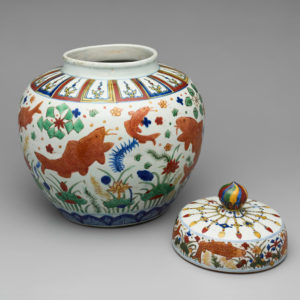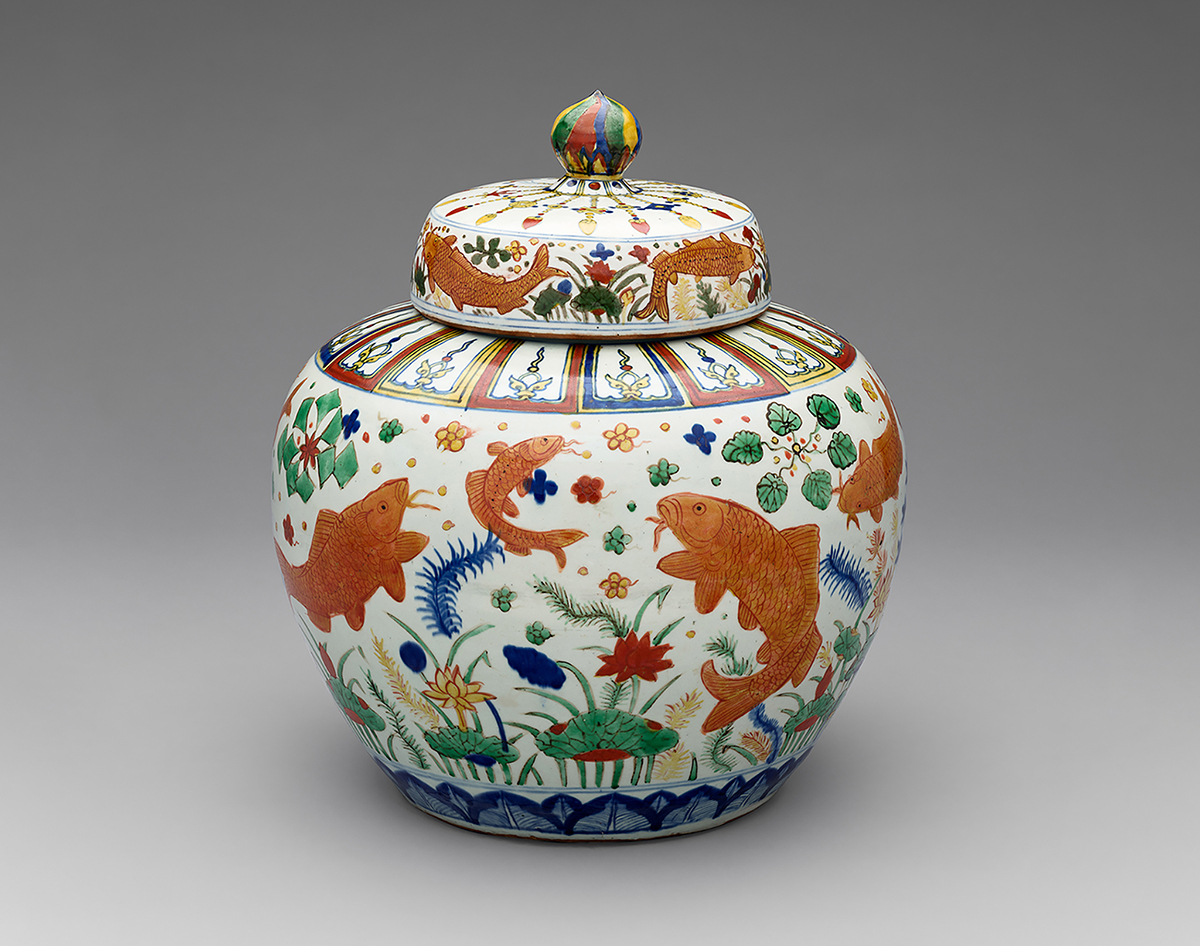This festive wine jar exemplifies the most advanced techniques of Ming dynasty porcelain.

Lidded jar with design of a lotus pond
China; Jingdezhen, Jiangxi province
Ming dynasty, reign of the Jiajing emperor (1522–1566)
Porcelain with underglaze blue and overglaze multicolor decoration
The Avery Brundage Collection, B60P78+
This festive wine jar made for the Emperor Jiajing (1522–1566) overflows with auspicious aquatic symbols. The vessel is considered one of the museum’s masterpieces because it exemplifies the most advanced porcelain techniques achieved at the imperial kilns at Jingdezhen. Its large scale and lavish depictions of complex subjects demonstrate innovative methods in working with porcelain. Its brilliant colors bucked the trend for more subdued decor that held sway during previous dynasties. Although made in multiples, today only a few dozen jars of this type are known.

Large jars of this type were among the most challenging and costly products of the Jingdezhen kilns. The artwork required pure kaolin clay and great control was needed to prevent breakage in all stages of the building and firing of its massive body. This vessel’s large scale and lavish depictions of complex subjects demonstrate various innovative decorative methods in working with porcelain. Potters at the imperial shop were skilled at controlling the extensive process of preparing the clay for forming and firing. To enrich the color and design, the potters achieved new glaze formulas, mixing finely ground minerals such as iron and cobalt to create seven bright hues. Seemingly Seamless It would have been impossible to make this jar from a single piece of clay due to its large size. The seam around the circumference of the body indicates where the two halves were joined. During the mid- to late-Ming dynasty, the court ordered the imperial workshop in Jingdezhen to produce similar large jars for placement in royal palaces and villas. Only perfect pieces that passed inspections were used — the number of jars that failed due to flaws was exceptionally high. Essential Ingredient: Kaolin The name “kaolin” is derived from Gaoling, a Chinese village near Jingdezhen, where it has been mined for centuries. Kaolin is a naturally occurring mineral used in porcelain as well as in making modern paper and paint. When mixed with water, it becomes plastic and holds a shape well. Fired in high temperatures it retains its white color and fuses, resulting in a tough yet delicate form, making porcelains and kaolin highly desirable. While kaolin is now a primary ingredient of all porcelain clays and mined all over the world, the naturally white kaolin of Jingdezhen is still unique to the region. The kilns of Jingdezhen were designed to produce the different atmospheres and temperatures necessary to fire various wares. The horseshoe-shaped floor plan of the imperial kilns allowed heat from the fire at the entrance to travel throughout the kiln chamber. Exhaust vents drew the fire into the kiln and out through the fire exit on the rear wall. This type of structure controlled both the temperature and the oxygen level in the firing chamber, ensuring consistent quality. The jar’s decorative motifs incorporate auspicious symbols that reflect the Jiajing emperor’s fascination with fish and aquatic plants. Inspired by the lotus pond, the imagery draws upon symbolic meaning and homophonic puns associated with immortality, eternal prosperity, and fertility. The jar’s lid is decorated with a colorful knob surrounded by beaded strings representing auspicious treasures including, from left, horns, an ingot, three flaming pearls, a lozenge, and scrolls, with pearls set between them. The fish, spawning many eggs, is a symbol of fecundity. The collective name for fish, yu, is a homophonic pun for abundance. An image of fish swimming in water conveys the saying: May your marriage be as harmonious as fish in water. The ceramic artists at Jingdezhen — often dubbed the “porcelain capital” — experimented with new decorative effects throughout the early and middle Ming dynasty (1368–1644). This artwork represents a prime example of one of their breakthroughs: the decoration of porcelain with multicolor enamels, known as wucai (literally, five-color), first achieved during the reign of the Xuande emperor (1425–1435). Wucai could include as many as seven color tones, as seen in this jar in the shades of green and orange. This bolder style only became accepted through imperial support. The decoration on this type of vessel required, in general, two firings. The blue areas were painted using cobalt, on top of which a clear glaze was applied and fired at a high temperature. Only the cobalt could withstand the high temperatures required to convert the clear glaze into a glasslike substance. Additional enamels were painted over the glaze for subsequent low-temperature firings. This process required highly skilled artisans and was time-consuming and costly. In accordance with rules governing the unified branding of imperial porcelain, the cobalt blue underglaze was used for the reign mark of the Jiajing emperor on the base of the jar. Newly formulated enamel colors like antimony-based yellow and diluted iron-based green were used on the jar in combination with traditional colors including red and forest green.
How Was It Made?
Decorative Motifs
Five-Color Enamel